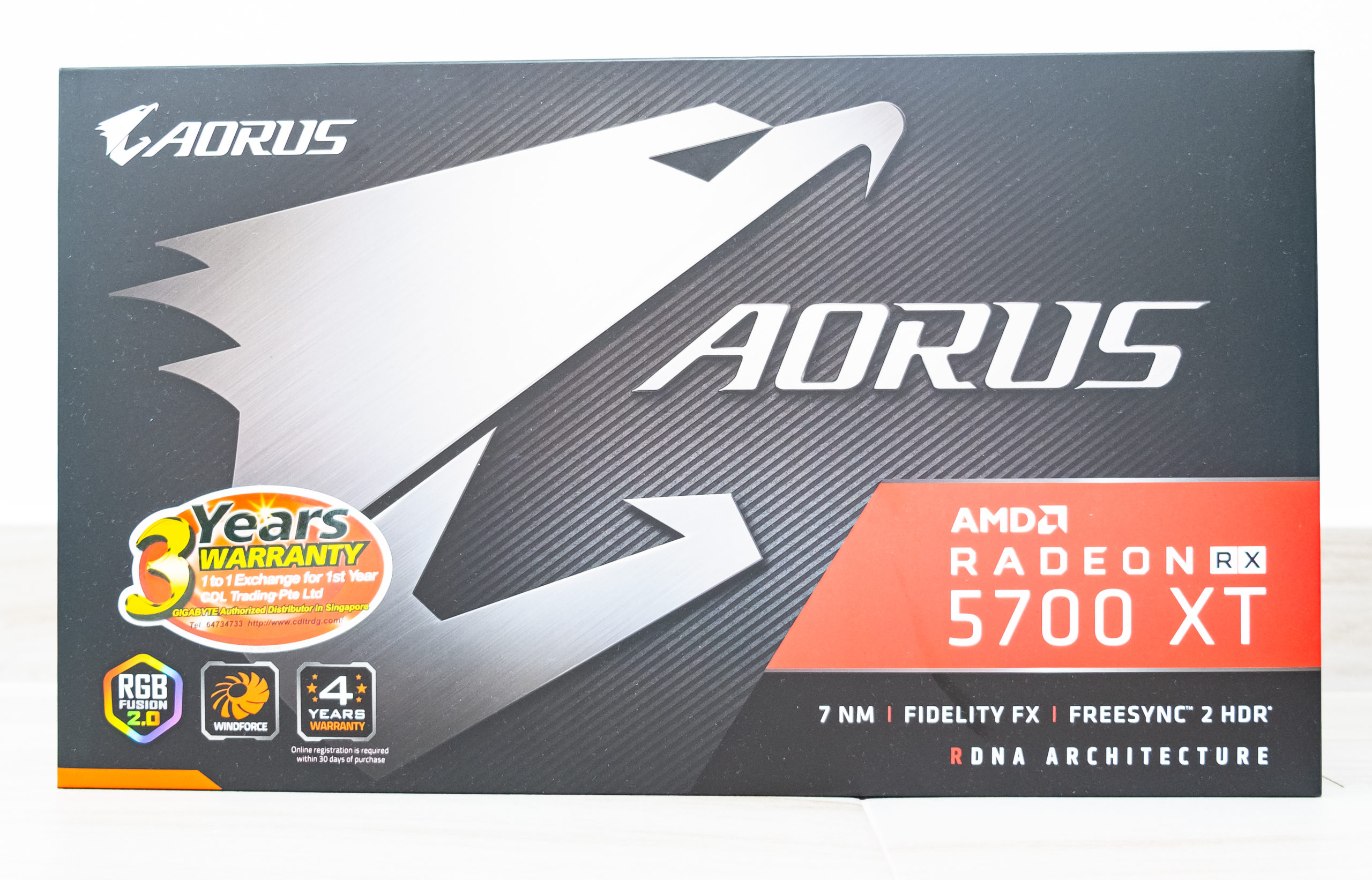The Gigabyte AORUS Radeon RX 5700XT 8G is AMD’s first high-end segment graphics card in over two years since the RX Vega series. It’s based on the brand new “Navi” architecture that leverages the 7 nm silicon fabrication process and brand new number-crunching machinery AMD calls RDNA compute units. These constitute the biggest update to AMD’s GPU design since the very first Graphics CoreNext (GCN) architecture in 2013. The RDNA is designed to bring about massive IPC improvements over GCN.

The Gigabyte AORUS RX 5700XT 8G features a custom-design PCB designed by Gigabyte with a massive 7+1phase VRM that draws power from a pair of 8-pin PCIe power connectors. The cooling solution is the Gigabyte Windforce 3X , the latest unique blade fan of high-end air-based alternate spinning cooling solutions from Gigabyte that features an aluminium fin-stack heatsink and a three of fans that turn off when the GPU is idling. Better cooling and power limits mean that the GPU is able to sustain its boost clock speeds better, resulting in more performance. There’s also a switch-enabled OC mode by default that speed up boost clock speeds to 2010 Mhz. The dual-BIOS feature switch let you switch between OC and Silent, but also lets you lower fan speeds via a “silent BIOS.” This card has a few of RGB LED along the front and top of the card, but we are disappointed with little RGB lighting around the card.
Features
- Powered by AMD Radeon™ RX 5700 XT
- Integrated with 8GB GDDR6 256-bit memory interface
- WINDFORCE 3X Cooling System with alternate spinning fans
- RGB Fusion 2.0 – synchronize with other AORUS devices
- Metal Back Plate
- PCI-Express 4.0 Support
- Boost Clock: up to 2010 MHz
- Game Clock: 1905 MHz (Reference card is 1755 MHz)
- Base Clock: 1770 MHz (Reference card is 1605 MHz)

The back of the card is cover with full length backplate.



Gigabyte’s Ultra Durable VGA technology which uses solid state capacitors, chokes and lower RDS(on) MOSFETs. Power delivery of this card 7+1, but using the more robust “Ultra Durable” hardware. Also there are eight Micron D9WCW GDDR6 memory ICs, which are native 14 GB/s chips.
- GPU PWM controller IC: The International Rectifier 35217 is a dual-loop digital multi-phase buck controller designed for voltage regulation.
The PWM IC controller chip is place on the back of the PCB.


Two 8-pins PCIe connectors require for the card. These power connectors both have white LEDs, which give you a quick status on power indication. Lights off are stable, blinking is abnormal power and lights on means the power plug is disconnected.

The Windforce 3X features three 80mm fans, with ribbed fan blades to add rigidity and reduce noise. And those fans spin in alternate directions to minimize turbulence and maximize air-flow through the heatsink fins. Speaking of the heatsink, there is a heat-plate under the assembly that makes contact with the card’s VRM and 8GB of GDDR6 memory, along with a larger array of thin-fins, linked together via 5-composite heat pipes and a copper heat plate, which make direct contact with the GPU. The overall design is 2.5-slots wide, which is wider than the blower on AMD’s reference design, but as you’ll see a little later, the Windforce 3X cooler affords significantly lower temperatures and it is much quieter too.



Display output on the card consists of three DisplayPorts (v1.4) , one HDMI (2.0b) and two HDMI (1.4b) ports.

How We Tested Gigabyte’s Aorus RX5700XT 8G
Radeon RX5700XT is the highest-level graphics card in AMD Navi-based segment. As such, our graphics workstation, based on an Gigabyte B450 AORUS M motherboard and AMD 3600X 6 cores processor. The ram we will be using is G.Skill’s F4-3600C16D- 16GTZNC memory kit. ADATA SX8200 500Gb M.2 NVMe SSD is used as well to run with benchmark.
We will be using latest AMD Adrenalin 20.7.1 and Windows 10 Professional Build 2004.
GPUZ: Gigabyte Aorus RX5700XT.

We will be comparing three graphics card below.
| Model | Gigabyte Aorus RX5700XT | Zotac RTX2080 AMP Extreme Core | Zotac RTX2070 Super AMP |
| GPU | AMD Navi 10 7nm | Nvidia Turing TU104 12nm | Nvidia Turing TU104 12nm |
| GPU Clock | 2010Mhz | 1875Mhz | 1750Mhz |
| Video Memory | Micron 8Gb GDDR6 256bits | Samsung 8Gb GDDR6 256bits | Micron 8Gb GDDR6 256bits |
| Memory Clock | 1750Mhz | 1750Mhz | 1750Mhz |
| Bandwidth | 448.0GB/s | 460.8GB/s | 448.0GB/s |
| Bus Interface | PCIex16 version 4.0 | PCIex16 version 3.0 | PCIex16 version 3.0 |
| Driver | Adrenalin 20.7.1 DCH | Nvidia 451.67 DCH | Nvidia 451.67 DCH |
Unigine SuperPosition Benchmark
Benchmark is a GPU-intensive benchmark that hammers graphics cards to the limits. This powerful tool can be effectively used to determine the stability of a GPU under extremely stressful conditions, as well as check the cooling system’s potential under maximum heat output.
| FPS Min | FPS Avg | FPS Max | Score | |
| Gigabyte RX5700XT | 32.33 | 39.33 | 46.99 | 5258 |
| Zotac RTX2080 | 40.11 | 52.01 | 66.78 | 6953 |
| Zotac RTX2070 Super | 36.25 | 47.38 | 60.95 | 6334 |

3Dmark Advanced Edition
3DMark includes everything you need to benchmark your PC and mobile devices in one app. Whether you’re gaming on a smartphone, tablet, notebook, or a desktop gaming PC, 3DMark includes a benchmark designed specifically for your hardware.
| Fire Stike Extreme | Time Spy | |
| Gigabyte RX5700XT | 12356 | 9315 |
| Zotac RTX2080 | 12651 | 10332 |
| Zotac RTX2070 Super | 11736 | 9573 |

VR Benchmark
The performance requirements for VR games are much higher than for typical PC games. So if you’re thinking about buying an HTC Vive or an Oculus Rift.
| Orange Room | |
| Gigabyte RX5700XT | 10141 |
| Zotac RTX2080 | 11729 |
| Zotac RTX2070 Super | 11744 |








